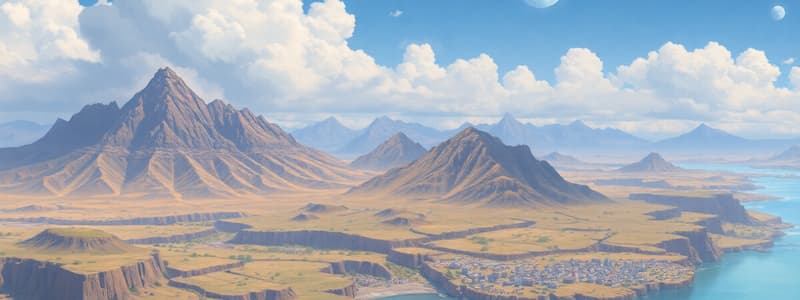Podcast
Questions and Answers
Which of the following best describes the primary focus of physical geography?
Which of the following best describes the primary focus of physical geography?
- Human activities and their impact on the Earth's surface
- The interactions between humans and the natural environment
- The spatial variations in cultural practices and landscapes
- The Earth's physical features and natural processes (correct)
Human geography primarily focuses on the study of landforms and their creation.
Human geography primarily focuses on the study of landforms and their creation.
False (B)
Name two key areas of study within physical geography.
Name two key areas of study within physical geography.
Geomorphology, Climatology, Hydrology, Biogeography
The study of population distribution, composition, and migration patterns falls under the domain of _______ geography.
The study of population distribution, composition, and migration patterns falls under the domain of _______ geography.
Match the following key areas of geography with their correct descriptions:
Match the following key areas of geography with their correct descriptions:
Which of the following is the best definition of GIS?
Which of the following is the best definition of GIS?
GIS is primarily used for studying historical documents.
GIS is primarily used for studying historical documents.
Give two examples of how GIS can be applied.
Give two examples of how GIS can be applied.
GIS enables users to identify patterns, trends, and relationships in ________ data.
GIS enables users to identify patterns, trends, and relationships in ________ data.
Match the following functions to the Geographic Information Systems (GIS):
Match the following functions to the Geographic Information Systems (GIS):
What is the primary focus of environmental geography?
What is the primary focus of environmental geography?
Environmental geography only focuses on the negative impacts of humans on the environment.
Environmental geography only focuses on the negative impacts of humans on the environment.
Name two environmental problems studied in environmental geography.
Name two environmental problems studied in environmental geography.
Environmental geography integrates concepts from physical and ________ geography.
Environmental geography integrates concepts from physical and ________ geography.
Match the environmental geography concepts with their appropriate descriptors:
Match the environmental geography concepts with their appropriate descriptors:
What is the primary focus of cultural geography?
What is the primary focus of cultural geography?
Cultural geography is not concerned with the relationship between culture and place.
Cultural geography is not concerned with the relationship between culture and place.
Name two examples of cultural traits studied in cultural geography.
Name two examples of cultural traits studied in cultural geography.
Cultural landscapes reflect the values and beliefs of different ________.
Cultural landscapes reflect the values and beliefs of different ________.
Match the cultural phenomena with their role in cultural geography:
Match the cultural phenomena with their role in cultural geography:
Flashcards
Geography
Geography
The study of the Earth's surface, encompassing physical features, human populations, and their interactions.
Physical Geography
Physical Geography
Focuses on the natural environment, studying Earth's physical features and processes.
Geomorphology
Geomorphology
Studies landforms and the processes that shape them, like erosion and tectonic plates.
Climatology
Climatology
Signup and view all the flashcards
Hydrology
Hydrology
Signup and view all the flashcards
Biogeography
Biogeography
Signup and view all the flashcards
Human Geography
Human Geography
Signup and view all the flashcards
Population Geography
Population Geography
Signup and view all the flashcards
Cultural Geography
Cultural Geography
Signup and view all the flashcards
Economic Geography
Economic Geography
Signup and view all the flashcards
Political Geography
Political Geography
Signup and view all the flashcards
Geographical Information Systems (GIS)
Geographical Information Systems (GIS)
Signup and view all the flashcards
Environmental Geography
Environmental Geography
Signup and view all the flashcards
Cultural Geography
Cultural Geography
Signup and view all the flashcards
Culture-place relationship
Culture-place relationship
Signup and view all the flashcards
Geography
Geography
Signup and view all the flashcards
Study Notes
- Geography is the study of the Earth's surface, including its physical features, human populations, and the interactions between them
- Geography seeks to understand the spatial relationships and distributions of phenomena
- It examines both the natural environment and human societies, and how they influence each other
- Geography is a wide-ranging discipline that bridges the natural and social sciences
Physical Geography
- Physical geography focuses on the natural environment
- It studies the Earth's physical features and processes
- This includes landforms, climate, vegetation, soils, and water
- Key areas are geomorphology, climatology, hydrology, and biogeography
- Geomorphology studies landforms and the processes that shape them, such as erosion and tectonic activity
- Climatology examines climate patterns and variations, including temperature, precipitation, and atmospheric circulation
- Hydrology focuses on water resources, including rivers, lakes, groundwater, and the water cycle
- Biogeography studies the distribution of plants and animals, and the factors that influence their patterns
Human Geography
- Human geography focuses on human activities and their impact on the Earth's surface
- It studies population, culture, economics, politics, and urbanization
- Key areas are population geography, cultural geography, economic geography, and political geography
- Population geography examines the distribution, composition, migration, and growth of human populations
- Cultural geography studies the spatial variations in cultural practices, beliefs, and landscapes
- Economic geography focuses on the location and organization of economic activities, such as agriculture, industry, and trade
- Political geography examines the spatial organization of political systems, including states, boundaries, and geopolitical relations
- Human geography explores how societies shape and are shaped by their environment
Geographical Information Systems (GIS)
- GIS is a technological tool for capturing, storing, analyzing, and displaying spatial data
- It integrates hardware, software, and data to create digital maps and perform spatial analysis
- GIS is used in a wide range of applications, including urban planning, environmental management, and transportation planning
- GIS allows for spatial data visualization and analysis
- It enables users to identify patterns, trends, and relationships in geographic data
- GIS is a powerful tool for decision-making and problem-solving in various fields
Environmental Geography
- Environmental geography examines the interactions between humans and the natural environment
- It studies environmental problems such as pollution, deforestation, and climate change
- It also focuses on conservation and sustainable development
- Environmental geography integrates physical and human geography concepts
- It seeks to understand the causes and consequences of environmental change
- It also aims to develop solutions for environmental problems
- It plays a crucial role in promoting environmental sustainability
Cultural Geography
- Cultural geography explores the spatial variations in cultural practices and landscapes
- It studies how culture shapes and is shaped by the environment
- It examines the diffusion of cultural traits, such as language, religion, and customs
- Cultural geography explores the relationship between culture and place
- It investigates how places are given meaning through cultural practices
- It also considers how cultural landscapes reflect the values and beliefs of different groups
- It provides insights into the diversity of human cultures and their interactions with the environment
Studying That Suits You
Use AI to generate personalized quizzes and flashcards to suit your learning preferences.



